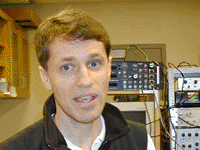 |
Dr.
Botond Roska, a postdoctoral fellow from Hungary, measured
output of retinal cells.
Robert Sanders photo |
Over
a period of nearly three years, Roska painstakingly measured
signals from more than 200 ganglion cells in the rabbit
retina as he flashed pictures of a featureless square or
circle. Ganglion cells are the eye's output cells, forming
the optic nerve connecting it to the brain.
"We
made very simple measurements on retinal cells, recording
excitation and spiking when we flashed squares and moving
spots in front of the eye," Roska said.
From
these, he and Werblin determined that there are about a
dozen different populations of ganglion cells, each spanning
the full visual space and producing a different movie output.
One group
of ganglion cells, for example, only sends signals when
it detects a moving edge. Another group fires only after
a stimulus stops. Another sees large uniform areas, yet
another only the area surrounding a figure.
"Each
representation emphasizes a different feature of the visual
world — an edge, a blob, movement — and sends
the information along different paths to the brain,"
Werblin said.
 |
| Robert
Sanders photo |
The
two researchers shared these detailed findings with software
designer David Balya in Hungary, who modeled the visual
processing on a computer, a preliminary step before actually
programming a CNN chip to simulate the image processing
that goes on in the eye. The computer model precisely mimics
the output of the ganglion cells of the retina, vividly
showing the difference between the world we see and the
information that actually is sent to the brain.
 Listen
to Frank Werblin
(right) explaining the language of cell interactions (audio
with photo).
Listen
to Frank Werblin
(right) explaining the language of cell interactions (audio
with photo).
"We
now are looking at the predictions the model makes when
viewing natural scenes — Frank's face or leaves on
the ground — and comparing them with what we measure
in actual retinal cells, to learn how good these predictions
are," Roska said.
continued